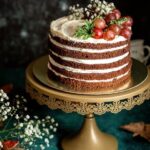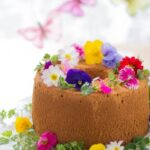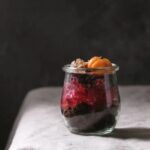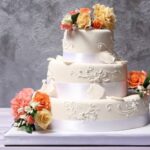Are you looking to take your cake decorating skills to the next level? Learn how to use an airbrush for cake decorating and elevate your creations with stunning, professional-looking designs. Using an airbrush can add dimension, depth, and creativity to your cakes, making them stand out from the rest. In this article, we will guide you through the process of using an airbrush for cake decorating, from choosing the right equipment to mastering different techniques and avoiding common mistakes.
When it comes to creating beautiful cakes, an airbrush can be a game-changer. Whether you’re a beginner or a seasoned baker, learning how to use an airbrush will open up a world of possibilities for your cake decorations.
In the following sections, we will walk you through everything you need to know about using an airbrush for cake decorating, including selecting the right airbrush and compressor, setting up your kit, practicing and familiarizing yourself with the equipment, mastering different techniques, avoiding common mistakes, and maintaining your airbrush for long-term use.
With our step-by-step guide and expert tips, you’ll soon be creating professional-looking designs on your cakes that are sure to impress friends, family, and clients alike. So let’s dive in and explore the exciting world of airbrushing for cake decorating.
Choosing the Right Airbrush and Compressor
When it comes to cake decorating with an airbrush, choosing the right airbrush and compressor is crucial to achieving professional results. There are a few key factors to consider when selecting your equipment.
Type of Airbrush
There are three main types of airbrushes: gravity-feed, siphon-feed, and side-feed. Gravity-feed airbrushes are typically recommended for cake decorating due to their efficient use of paint and easy clean-up. Consider the type of projects you will be working on and choose an airbrush that best fits your needs.
Compressor Considerations
Your choice of compressor will depend on how often you plan to use the airbrush, as well as your budget. Look for a compressor with adjustable pressure settings, as this will give you more control over the airflow and paint application. Also, consider the noise level of the compressor if you plan to work in a home kitchen or shared space.
Budget and Quality
It’s important to find a balance between budget and quality when choosing an airbrush and compressor. While it can be tempting to opt for the cheapest option, investing in a higher-quality airbrush and compressor can lead to better results and longer-lasting equipment.
By carefully considering these factors when choosing your airbrush and compressor, you can set yourself up for success in cake decorating with an airbrush.
Setting Up Your Airbrush Kit
When it comes to cake decorating, using an airbrush can take your creations to the next level. But before you start creating stunning designs on your cakes, you need to make sure you have the right equipment and know how to set it up properly.
The first step in setting up your airbrush kit is to choose the right airbrush and compressor for your needs. There are different types of airbrushes, such as gravity-feed, siphon-feed, and side-feed, each with its own advantages. Consider factors like ease of use, maintenance, and the type of designs you want to create when choosing the best airbrush for you.
Once you have your airbrush and compressor, it’s time to set them up. Start by assembling the airbrush according to the manufacturer’s instructions. Then, connect the air hose from the compressor to the air inlet on the airbrush. Make sure everything is securely attached and that there are no leaks. Finally, adjust the airflow and pressure on your compressor according to the recommendations for your specific airbrush model.
Now that your kit is set up properly, it’s time to practice and familiarize yourself with using an airbrush for cake decorating. Experiment with different techniques and get a feel for how the airbrush handles. This will help you gain confidence and precision when using it on actual cakes.
Finally, don’t forget about safety precautions while setting up your airbrush kit. Always work in a well-ventilated area or use a spray booth to avoid inhaling any fumes from edible paints or other substances commonly used in cake decorating.
| Types of Airbrushes | Advantages |
|---|---|
| Gravity-Feed | Precise control over paint flow. |
| Siphon-Feed | Can hold more paint and suitable for larger projects. |
| Side-Feed | Easier to switch between colors quickly. |
Practice and Familiarize Yourself With the Airbrush
So, you’ve chosen the right airbrush and compressor for your cake decorating needs, and you’ve set up your airbrush kit. Now comes the fun part – practicing and familiarizing yourself with the airbrush. Before you start using it on a cake, it’s essential to spend some time getting comfortable with your airbrush and learning how to control it effectively.
To begin, start by practicing on a piece of paper or cardboard. This will allow you to get a feel for how the airbrush works, as well as how different pressures and nozzle sizes affect the spray pattern. Experiment with different distances from the surface and try creating different shapes and gradients to understand what the airbrush is capable of.
Once you feel confident with basic techniques on paper, move on to practicing on a frosted dummy cake or even a simple sheet cake. This will give you a better sense of how the edible colors interact with icing and fondant. Pay attention to how the colors blend together, how much pressure is needed for certain effects, and how much distance from the cake is ideal for achieving even coverage.
Remember that practice makes perfect when it comes to using an airbrush for cake decorating. Take the time to familiarize yourself with your equipment before attempting more intricate designs on actual cakes. Before long, you’ll be able to confidently use an airbrush for creating stunning designs on all your baked creations.
- Practice basic techniques like creating gradients, shapes, and blending colors
- Experiment with different pressures, nozzle sizes, and distances from the surface
- Start by practicing on paper or cardboard before moving on to frosted dummy cakes or sheet cakes
Different Techniques for Airbrushing Cakes
Airbrushing cakes is a versatile and creative way to decorate baked goods. There are several different techniques that can be used to achieve beautiful and professional-looking results.
Stencil Techniques
One common technique for airbrushing cakes is using stencils. Stencils are a great way to create intricate designs and patterns on cakes, such as floral motifs, geometric shapes, or even themed images like superheroes or animals. To use stencils with an airbrush, simply hold the stencil in place over the cake and spray the desired color lightly and evenly over the stencil. Carefully lift the stencil away to reveal the design underneath.
Color Blending
Another popular technique for airbrushing cakes is color blending. This involves mixing different colors of food coloring in the airbrush cup to create custom hues that can be sprayed onto the cake. Color blending allows for smooth transitions between colors and gradients, perfect for creating ombre effects or realistic shading on cake decorations.
Freehand Techniques
For the more experienced cake decorator, freehand airbrushing techniques can be used to create unique and personalized designs on cakes. By adjusting the pressure and angle of the airbrush, decorators can create fine lines, delicate details, and even intricate artwork directly onto the surface of the cake. With practice and a steady hand, freehand airbrushing can yield stunning results on cakes.
By mastering these different techniques for airbrushing cakes, decorators can elevate their cake decorating skills to new heights, creating visually stunning and professional-looking cakes that are sure to impress clients and guests alike. Overall if you utilize these techniques properly using an airbrush for cake decorating will help you boost your decorating skills quickly.
Common Mistakes and How to Avoid Them
Airbrushing cakes can be a fun and creative way to add unique designs and colors to your baked creations. However, like any new skill, there are common mistakes that beginners often make when using an airbrush for cake decorating. In this section, we’ll discuss some of these common mistakes and provide tips on how to avoid them.
Common Mistakes
When first starting out with airbrushing cakes, it’s easy to make some common mistakes that can affect the overall outcome of your designs. Some of these mistakes include:
- Overspraying: Applying too much color at once, resulting in blurred or runny designs.
- Clogging: When the airbrush nozzle becomes clogged with dried color, causing uneven spraying.
- Inconsistent coverage: Failing to maintain an even distance from the cake while spraying, resulting in uneven color distribution.
How to Avoid Them
To avoid these common mistakes and achieve professional-looking results when using an airbrush for cake decorating, there are several tips and techniques you can use:
- Practice proper distance control: Maintaining a consistent distance between the airbrush and the cake is crucial for even coverage. Practice on a piece of paper before airbrushing your cake.
- Clean your airbrush regularly: Prevent clogging by cleaning your airbrush thoroughly after each use. Use a specialized cleaning solution or warm soapy water to flush out any dried color.
- Use light layers of color: To prevent overspraying, apply thin layers of color at a time. Allow each layer to dry before adding more color if needed.
By being mindful of these common mistakes and implementing the tips provided, you can enhance your skills in using an airbrush for cake decorating and create stunning designs on your baked creations.
Cleaning and Maintenance of Your Airbrush
Now that you have successfully used your airbrush for cake decorating, it is important to understand the proper cleaning and maintenance techniques to ensure its longevity and optimal performance. Cleaning your airbrush after each use is crucial in preventing clogs and blockages that can affect the quality of your cake decoration.
Start by disassembling your airbrush carefully, following the manufacturer’s instructions. Use a cleaning solution specifically made for airbrushes to clean all the individual parts thoroughly. Pay special attention to the nozzle, needle, and color cup to remove any leftover residue. Once cleaned, reassemble the airbrush and test spray it with water or cleaning solution to ensure everything is functioning properly.
In addition to regular cleaning, proper maintenance of your airbrush is essential. This includes regularly checking for any signs of wear and tear on the components, such as the needle or nozzle, and replacing them when necessary. Keeping your compressor clean and free from dust or debris is also important for its longevity.
Proper care and maintenance of your airbrush will not only extend its lifespan but also ensure that you continue to achieve professional results in your cake decorating endeavors.
| Cleaning and Maintenance Tips | Benefits |
|---|---|
| Regularly clean all parts of the airbrush using a specialized cleaning solution | Prevents clogs and blockages |
| Check for signs of wear and tear on components and replace when necessary | Ensures optimal performance |
| Keep compressor clean and free from dust or debris | Extends compressor lifespan |
Final Tips and Tricks for Professional Results
In conclusion, utilizing an airbrush for cake decorating can take your creations to the next level. By following the tips and techniques outlined in this article, you can achieve professional-looking results that will impress your clients and guests. Remember that choosing the right airbrush and compressor is essential for achieving the desired effect, so take the time to research and invest in quality equipment.
Setting up your airbrush kit properly is crucial for a smooth working process, so follow the manufacturer’s instructions carefully. Practice and familiarize yourself with the airbrush before using it on a cake to ensure that you have full control over the tool. Experiment with different techniques for airbrushing cakes, such as stenciling and shading, to add depth and dimension to your designs.
It’s important to be aware of common mistakes that can occur when using an airbrush for cake decorating and learn how to avoid them. Additionally, regular cleaning and maintenance of your airbrush will prolong its lifespan and ensure consistent performance.
With these final tips and tricks, you’ll be well-equipped to create stunning cakes that showcase your skills as a professional decorator. As you continue to practice and refine your techniques, you’ll discover new ways to use an airbrush for cake decorating that will set your creations apart from the rest.
Frequently Asked Questions
Can I Use Regular Food Coloring in My Airbrush?
Using regular food coloring in an airbrush is not recommended. Regular food coloring can clog the airbrush and cause inconsistent spraying. It’s best to use specially formulated airbrush colors for best results.
Can I Use Airbrush on Buttercream?
Yes, you can use an airbrush on buttercream. It’s a great way to add intricate designs, gradients, or even just a pop of color to your buttercream cakes. Just make sure the buttercream has crusted before airbrushing.
What Is the Best Frosting for Airbrushing?
The best frosting for airbrushing is one that has a smooth and firm consistency, such as American buttercream or ganache. These frostings provide a good surface for the airbrush colors to adhere to and create a more professional finish compared to softer frostings like whipped cream or cream cheese frosting.

Welcome to my blog about home and family. This blog is a place where I will share my thoughts, ideas, and experiences related to these important topics. I am a stay-at-home mom with two young children. I hope you enjoy reading it! and may find some helpful tips and ideas that will make your home and family life even better!





